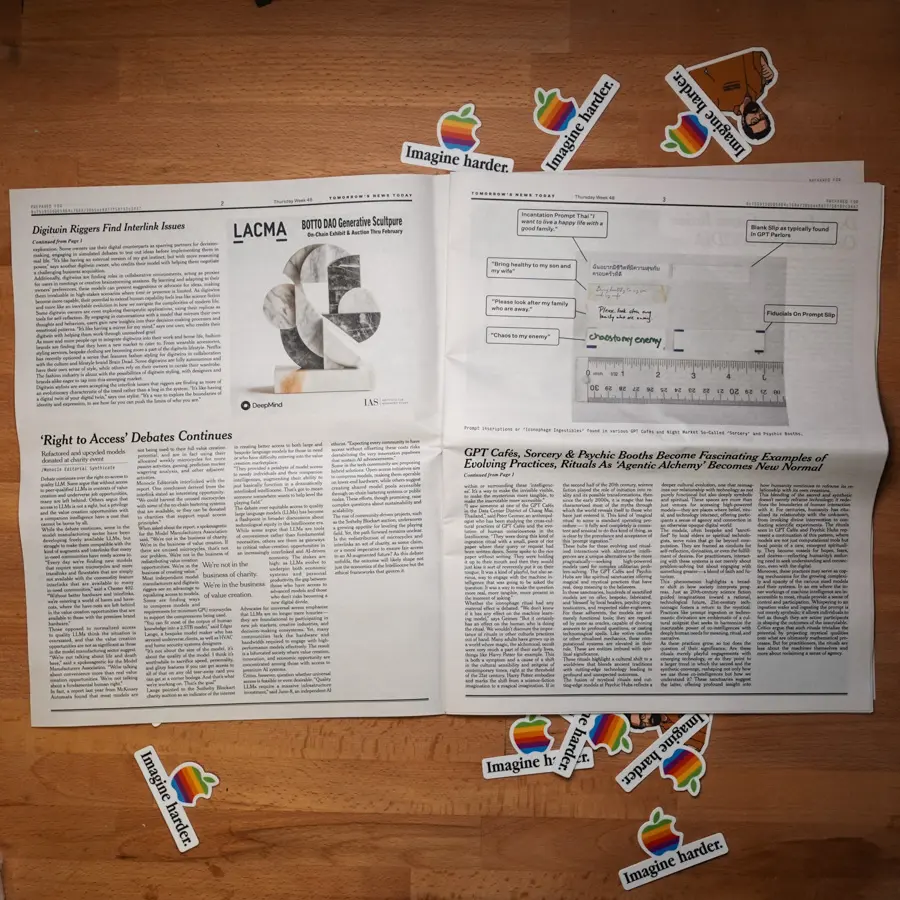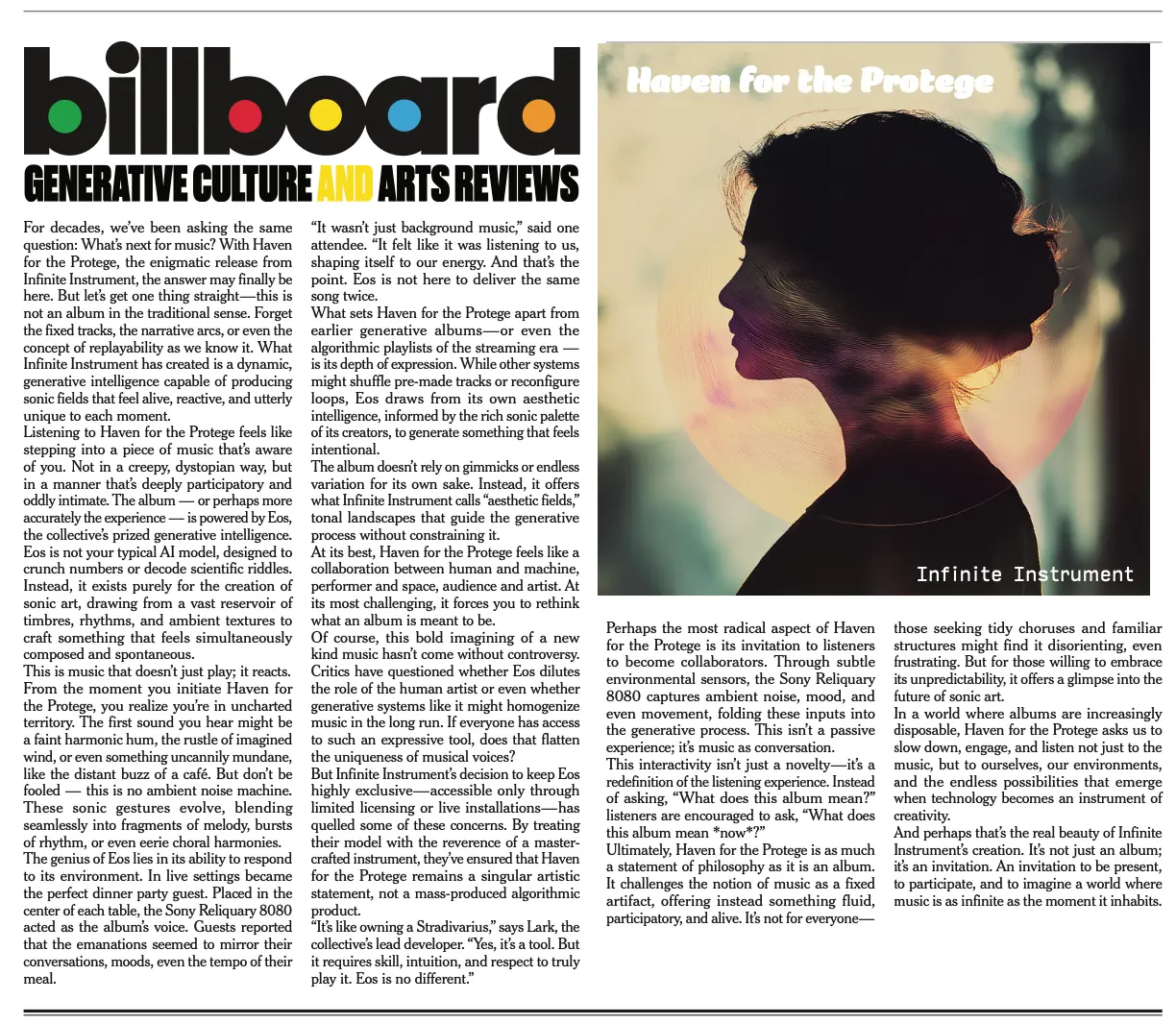
What is the value and purpose of this kind of Design Fiction artifact? Can we understand it as an augmentation of the typical analytic-minded trends and forexasting mechanisms that the business-oriented person values? What are we to do with these kinds of things given that they do not (always) lead immediately to clear decisions or solutions.
Look at this project as a Design Fiction artifact that imagines into or from a world where artificial intelligence is mundane, woven seamlessly into the fabric of everyday life. We used this as one of the prompts/provocations leading into a two-day workshop on AI policy and strategy. Through the newspaper we explored the implications of AI futures through speculative narratives and future artifacts. This was created over the course of about two weeks leading up to the workshop itself.
Each artifact in the newspaper (e.g. advertisements, classified ads, news articles, etc.) was created to provoke and inspire the workshop participants to think about the implications of AI futures, focusing on specific topic areas — domesticity, sports, third spaces, augmented reality, health/wellness/medicine, spirituality/belief, education, consumer culture, music, arts & entertainment, crime/malfeasance, agentic (aligned & misaligned) intelligences, work, conviviality, Each was also an extrapolation of current trends in AI and machine learning, as well as a reflection of the broader societal, ethical, and policy implications of increasingly pervasive intelligent systems.

When considering the role of creative exploration in business, especially speculative practices like Design Fiction, many analytic-minded professionals may ask: “What’s the tangible value?” It’s a fair question. Businesses need clear outcomes and measurable insights to justify their investments. Yet, when I bring these kinds of creative approaches to client work, and when applied thoughtfully, I always see a unique advantage emanate from the work: the coversations go from sensing an uncertain future to one that is relatable and tangible enough to discuss and act on.
Take, for example, a Design Fiction artifact like a newspaper that has come through some quantum entangled newsstand that has passed through a world in which artificial intelligence is as normal, ordinary, and everyday as wheels on luggage and morning coffee. At first glance, it may appear whimsical or detached from the hard realities of strategic planning. But its value lies precisely in its ability to reframe the abstract and speculative into the concrete and imaginable.
For many businesses, engaging with “the future” often means wading through a sea of hype. Artificial intelligence, in particular, is frequently portrayed as either an omnipotent savior or an existential threat. Just last week OpenAI intimated its intelligence has achieved a degree of reasoning yet to be achieved by any other machinic intelligence. Then you have the existential threat gang, seemingly angered by the misrepresentation and misguidance of AI development. These polarized narratives can cloud judgment, making it difficult to discern realistic opportunities from improbable fantasies.
A future newspaper avoids these traps. Instead of proclaiming AI will revolutionize everything, and not erring towards dystopian narratives, it imagines a world where AI is just…normal. The mundane, everyday existence of AI in the newspaper’s speculative world creates an accessible starting point for discussion. This doesn’t mean the world is perfect. In my newspaper, the world feels full of potential even as miscreants adopt AI for their nefarious purposes – hacking sports simulations, debating ‘right to access’ policies to ensure everyone has access to robust AI models, mechanisms to mitigate errant machinic hallucinations, even as others more enamored with the ethereal and religious undertones of a non-human intelligent entity have found solace in machines that wonder rather than machines that discern fact. This newspaper from an AI future invites the reader to see not only what changes but also what stays the same.

Design Fiction artifacts like this newspaper are not storytelling in the traditional sense. They don’t predict the future or provide linear narratives. Instead, they serve as provocative tools for thinking. A future newspaper presents a range of scenarios—social, cultural, economic, and technological—that feel grounded and plausible. Through these snapshots, it transforms abstract trends into concrete implications.
For example, a headline about “debates over equitable access to premium AI” prompts reflection on issues of digital inclusion and inequality. An article on “digitwin companions” sparks conversations about consumer desires for personalization and ethical concerns over data ownership. These speculative elements create a sandbox where businesses can explore critical questions:
This approach allows businesses to engage with the future in a way that traditional market forecasts or trend reports cannot.
Design Fiction artifacts also serve another crucial function: they de-risk decision-making. By creating vivid, detailed visions of possible futures, they help businesses identify potential blind spots in their strategies.
Consider the risks highlighted by speculative headlines about AI governance or unintended consequences of digitized personalities. These insights, drawn from a plausible world, allow stakeholders to address challenges before they materialize. Whether it’s rethinking product designs, adjusting marketing strategies, or lobbying for proactive regulations, a future newspaper provides a strategic edge.
Critics of speculative approaches may argue that they don’t lead directly to decisions or solutions. This critique misses the point of Design Fiction, which is meant to activate discussions and considerations in a context that allows for the unexpected and unanticipated. A newspaper from a possible future isn’t meant to provide answers. Rather, it’s meant to provide a container into which one can wonder, wander and consider possible/plausible outcomes in a variety of ways. A newspaper from a possible future pushes decision makers to think expansively, consider alternative perspectives, and innovate beyond the boundaries of current assumptions. What if the future were like this? What would we do? How would we prepare? In a rapidly evolving landscape like artificial intelligence, where change is constant and complexity high, this kind of thinking is essential.
Design Fiction, exemplified by a future newspaper, is not a replacement for analytic methods but a complement to them. It’s an augmentation. In this particular effort, the newspaper served as context setting, providing a portal into a possible world, fraught as much as it is fantastical It adds depth, imagination, and nuance to conversations and strategic thinking.
Remember that Design Fiction is not a replacement for the more traditional analytic methods used for forecasting, futuring, and such. Design Fiction is a complement to these methods. A way of offering multiple perspectives, of providing a more holistic view of the future. It is a way of making the future feel real, tangible, and actionable. It is a way of making the future feel imminent. When wrestling with uncertainty, Design Fiction provides some tools to help channel the complexities without probing explicitly for ‘the answer’ or ‘the product’ or ‘the policy’. It becomes a tool for clarity, conversation, and clearing the space for vigorous and hands-on exploration. When the future is made relatable in these ways, one can feel the empowerment to imagine what’s next as well as prepare for it with a certain degree of confidence — if only because the path forward has been explored and articulated in a material way.
Would you dismiss a prototype because it doesn’t function yet? Probably not. You’d see its value in illuminating possibilities and sharpening the path forward. A future newspaper is no different. Think of this newspaper from a possible future as a kind of prototyping platform for and from the future. It is an artifact that helps us think better about today’s decisions.
See Also